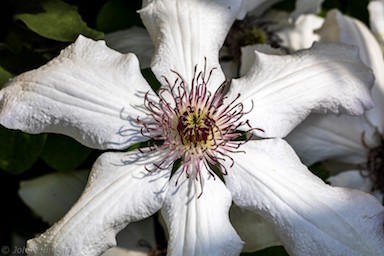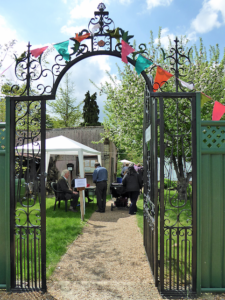The garden was understandably closed to visitors during the lockdown for several weeks. Since re-opening in the second week of June, we have rarely been so busy. It is wonderful now to see lots of visitors enjoying the garden as a safe and peaceful haven to meet up with friends and family. At the time of writing, the museum and the archives are still closed and we do not anticipate opening any time soon. Our Easter event in April and the Anniversary Fete in May were cancelled, but we were able to open for the National Garden Scheme on 28th June and 5th July. However, we have decided to cancel all other events for 2020, including the Horticultural Show.

The Challis Trust has supported the National Garden Scheme since the garden was first opened to the public in 2009. We were somewhat surprised, but delighted, at the annual meeting of the Cambridgeshire NGS group, to be awarded an inscribed trowel in recognition of opening the garden for ten consecutive years. As you are probably aware, the NGS raises money from garden openings, such as ours, to raise money for key nursing and caring charities, including Macmillan Cancer Support, Marie Curie, Hospice UK, Carers Trust, Queen’s Nursing Institute, Parkinson’s UK, Perennial and many others. This is especially pertinent at the present time, with many of these organisations on the front line in the fight against coronavirus. They need our money more than ever before. Our two open days raised around £700 for the NGS, so thank you to everyone who supported the Open Garden events.

The NGS has donated around £3 million pounds annually in recent years, but it estimates its income will be down by 80% this year due to the lockdown. This amounts to a huge shortfall in funding for many of the charities it supports. If you have been affected by the pandemic or have experience of any of these charities, please consider making a donation to the NGS in lieu of visiting a garden this year, to enable it to continue to support these important charities. You can watch some virtual garden tours online at www.ngs.org.uk and make a donation there.
We managed to continue basic maintenance in the garden through the lockdown. The garden is looking very good now; it is such a pity that visitors could not see it in spring and early summer. There were very good displays of spring flowers through February to April, but the exceptional hot and dry conditions in April put an early end to these. Early-flowering summer shrubs and trees put on good shows, notably Laburnum, Philadelphus and lilacs. In the herbaceous borders, irises, peonies, penstemons and geraniums all blossomed well. ‘Gaps’ in these plantings have now been filled with colourful annuals raised in our glasshouses, including begonias, zinnias, cornflowers, pelargoniums, salvias and rudbeckias. The wildflower meadow in the centre of the main lawn is at its best now. Lots of colour to come in the summer months!
There is a good stock of plants in our nursery. Annuals, herbaceous perennials, grasses, alpines and some shrubs and trees are all available. We also expect to sell half-standard two-year old ‘Mary Challis’ apple trees in the autumn. There is limited stock, so please let us know if you would like us to reserve one for you.
Very sadly, an old walnut tree died earlier this year and had to be removed. However, it will be given a new lease of life by the woodcarver Ben Hayford, who created ‘Gerry the giraffe’ next to Merlin Mica’s store. The carving should be completed by the time you read this. Do come and have a look at the new incarnation.
I’m sure the wildlife in the garden benefitted from the peace and quiet of the lockdown. The spring birdsong was delightful this year, with goldcrests, goldfinches, chaffinches, blackcaps, thrushes, robins and wrens singing throughout the day. In the winter, a single red-legged partridge was present but has since moved on and been replaced by a male pheasant – a very colourful addition. Hedgehogs are also often seen. For those of you interested in birds, from 2017 we’ve compiled a list of birds seen in or from the garden, and in May reached the milestone of fifty species – not bad for a semi-suburban setting. The fiftieth record was something of a surprise – a pair of common terns passing overhead. These birds are almost certainly part of the small colony breeding at Dernford Reservoir. It is surprising what there is to see if you stay alert to the sounds and sights around you.
All three of our beehives are occupied this year and developing well. The two flow hives received swarms collected locally in 2019 and came through the winter intact. A first small harvest of honey was extracted from one of these hives in early May, giving a mixture of comb honey and set honey. The prospects for the summer harvest are promising. Fingers crossed!
For obvious reasons, there is no activity in the Challis house at present or for the foreseeable future, so little to report on in the museum and archives. Our team of archivists are keen to resume their work sorting and cataloguing materials and artefacts. Planned exhibitions are on hold but will be set up as soon as circumstances allow. As they say ‘watch this space’. Meanwhile, stay alert and stay safe. Mike Redshaw
Published in Sawston Scene, June–September 2020



